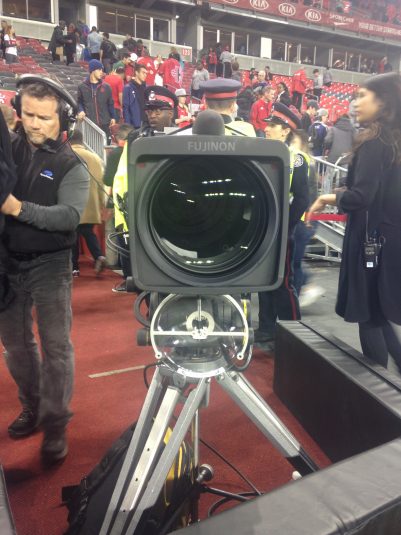Politeness Pays Off for Canadian Onfield Audio
Salty language isn’t a problem despite the ability to capture more sound
Story Highlights
If Canadian sports viewers get a bit more real-time, up-close sound from the field, the pitch, or the rink, it may be because of a subtle but significant cultural difference. Unlike in the U.S., where leagues and networks keep a tight leash on on-field and player audio, sound gathered from the sidelines of Canadian baseball, CFL, and MLS games tends to be curated by the A1s and A2s themselves, who are prepared to lower a parabolic or pull back an effects-submix fader on their own. Helping the process is a greater awareness among players to keep their tongues in check during games, something that many say comes more naturally to inherently polite Canadians.
That’s what Steve Koubridis, a longtime Toronto-based freelance A1 for TSN and Dome Productions for football, hockey, and soccer games, has discovered, mixing all three of those sports and worked comms audio for ESPN coverage of the X Games and Little League World Series. Two years ago, he introduced the A1 for the Grey Cup (the CFL’s equivalent of the Super Bowl) to the deeper 26-in. parabolic-dish microphones from Klover that Koubridis had encountered while working on some U.S. games. The 26-in. dishes captured sideline audio better than the ones the network had been using, enough so that the broadcasters purchased five sets of them.

A 9-in. Klover parabolic mic positioned beneath a remotely controlled camera covering centerfield at an MLS match captured more sound than the shotgun atop the camera.
That paved the way for another experiment Koubridis tried earlier this year. He got hold of a new 9-in. Klover parabolic and positioned it beneath the remotely controlled camera covering centerfield at an MLS match. Atop the camera lens was a Sennheiser 816 long shotgun, the same microphone in the same position that he had been using for years. However, he discovered, the 9-in. parabolic was able to capture far more sound than the shotgun mic.
“There was really no comparison,” he says. “We did an A-B comparison, and we could hear the onfield chatter and ball kicks very, very clearly. There was no wind noise, and, with the microphone under the lens, it was sheltered from the rain sound, too.”
Since then, Koubridis has also used the same combination of camera and small parabolic on a CFL game, the Calgary Stampeders’ home opener against the Ottawa Redblacks. He mounted the parabolic on a camera cart, allowing the microphone to get between the two teams’ benches, which are on the same side of the field in CFL stadiums.
“That let me get sound I’d never been able to get before,” he recalls. “We don’t have a microphone on the center in the CFL like you do in the NFL, so this was able to pick up sound from so many places that had been inaccessible to us before.”
Koubridis credits U.S. A1s who pioneered onfield sound, such as late ESPN audio guru Ron Scalise, for paving the way for Canada to begin to enhance its effects sound for sports. That’s now happening at a fairly fast clip, thanks to less (though certainly not an absence of) institutional concern about salty language making it to air and the combination of sonically vigilant A1s, verbally circumspect athletes, and more-precise sound-gathering technologies.
“The parab operators here know that, when the whistle sounds, they’ll lower the dishes and raise them again when they hear the huddle clap,” Koubridis explains. “That makes the mixers’ job easier, too. As a result, we’re now getting more of the cadence, more of the helmet crashes, more great onfield sound in general. We’re all working together to bring the viewer right down on the field.”
